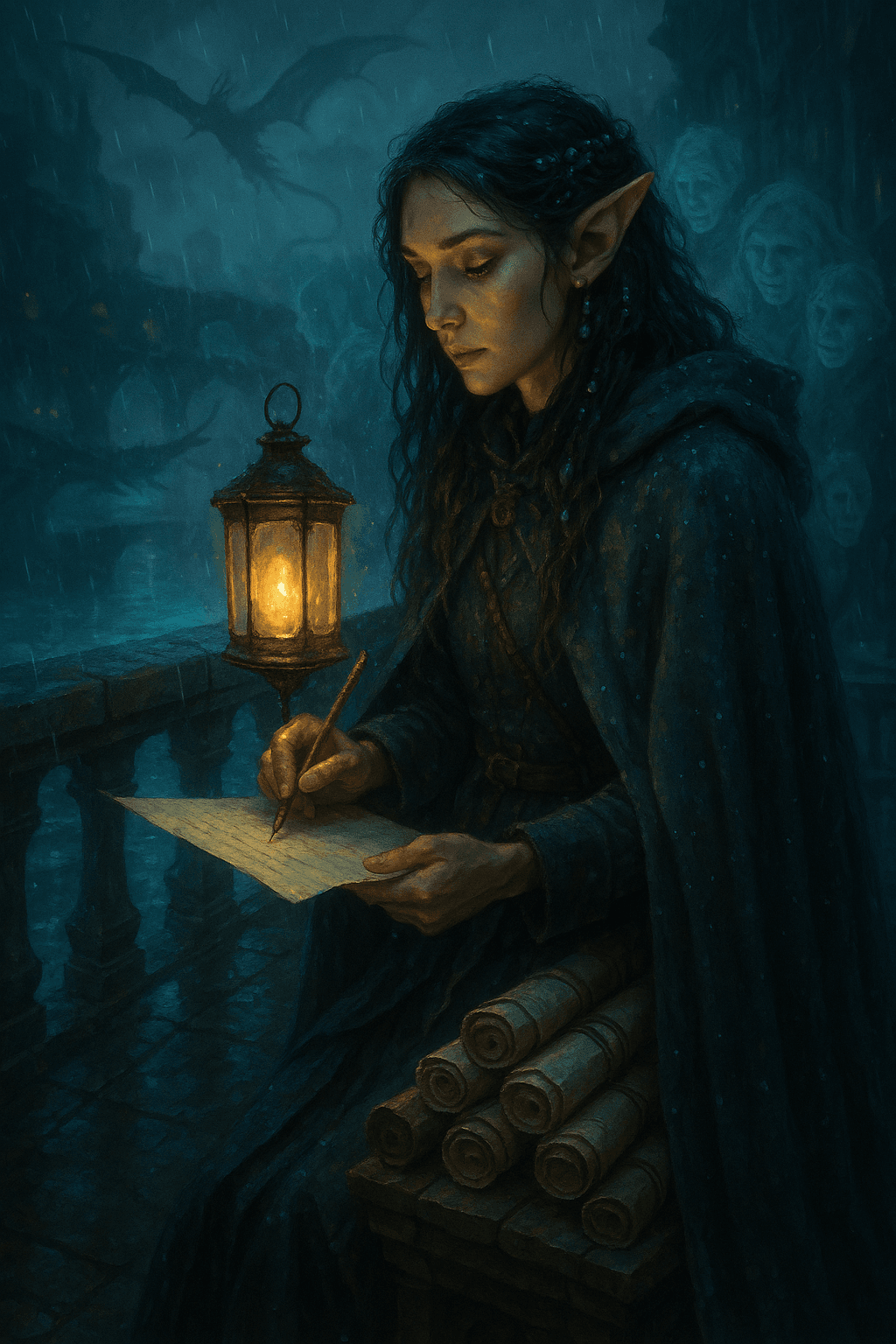Naelira Tideloom
Memory is a tide—draw it back, or it takes the shore with it.

They say House Elavorn keeps two kinds of books: those written in ink, and those written in water. Naelira Tideloom learned to read both. She was not the loudest voice in the halls of Elavorn’s Rest, nor the most decorated diver of the salvage bands—but when questions turned fragile and arguments grew sharp, Naelira would unroll her wet-proof vellum, set a quiet weight on each corner, and begin to write until the room remembered what it was trying to save.
Fracture.
After the Shattering, when Vaelorien drowned and the world learned new words for grief, Naelira walked the flooded terraces with a lantern cupped in both hands. Mist-Dragons threaded the blue hours like prayers; Tidewyrms kept their patient vigil below. She took their silhouettes as chapter headings, not omens. “Write the thing that refuses to vanish,” she told herself, and set about cataloging lives.
She organized the refugee registers by the last street remembered, not by title—because memory, she argued, holds maps before it holds rank. She recorded the names of drowned balconies and the hymns sung from them; she sketched the way coral colonized a library staircase and noted which shelves the reef spared, as if it, too, kept a canon. When scavengers came with quick pockets and quicker justifications, she did not fight them with blades. She fought them with lists and witness. Her ledgers made theft into history’s enemy, and that is a harder thing to dodge than guards.
Letters began to arrive from the mire—thin vellum that smelled faintly of night-bloom and secrets. Mistcaller Nyvra wrote the first, an inquiry wrapped around a compliment: We hear your memory is a net. Ours catches different fish. Shall we compare? Naelira answered with care. She believed the Whispering Bloom’s interest was not mercy but method, yet she also knew that knowledge hoarded sinks as surely as stone. So she sent copies, never originals, marked with tide-stamps proving provenance; in return came fragments of travelers’ recollections siphoned by Memory Drakes: street names spoken in dreams, the taste of a festival’s smoke, a lullaby’s missing second verse. She disliked their means. She kept the verses anyway, with a margin note—Source contested; meaning true.
In those years she listened more than she led. Lady Serelien’s sorrow could fill a hall; Alarion Deepwake’s stoic resolve could anchor a fleet. Naelira’s gift was gentler: she made rooms where remembrance was possible. She brewed tea in chipped cups. She timed interviews to the tide so that voices matched the rhythm of rising water and went less brittle around the edges. She could coax details from the tight-fisted—What did the bells sound like at dusk?—and then render the answer so exactly that even the Drowned Spirits paused beside her tables, reading with a silence that felt like consent.
Twilight.
Time roughened the edges of grief into work. Vaelorien divided between those who wanted to mourn and those who wanted to raise towers from the seafloor. Naelira stood between them with a ledger and a rope. “Lift what you can without tearing what holds it,” she would say, and then chart how to make that true. She joined recovery crews to document vault-lifts and siege theologies alike, arguing that methods would one day be judged as sternly as outcomes. When Restorationists proposed wrenching whole districts skyward, she unrolled a map of currents and memories and traced the invisible houses: this corner held three generations of wedding songs; that courtyard taught a hundred children to read by lanternfish. The plan bent toward mercy because the map refused to forget.
Her correspondence with the Mire continued, thinner now and wary. Nightshade Weaver’s script replaced Nyvra’s—runes that seemed half shadow themselves. The Bloom wanted patterns, not people. Naelira answered with people anyway, distilled to patterns that could not be weaponized without breaking the story that carried them. She was not naïve. She knew her caution could slow nothing but harm, and sometimes only for a while. Yet slowing matters when the world is healing; it is the difference between a scar you can live with and one you cannot.
Within House Elavorn, she became a hinge between living and dead. The Drowned Spirits grew willful, their autonomy a kind of afterlife adolescence. Naelira learned to ask them for permissions the living could not grant and to accept refusals the living did not understand. She convinced Mist-Dragons to allow scholars into flooded stacks for measured minutes at a time; she cataloged which bells soothed them and which frightened, and wrote a primer titled How to Knock on Water. When Aeliryn’s diplomacy needed proofs, Naelira brought them—names, dates, the testimony of tide and stone. And when young divers returned shaken by the loss of a partner to dark water, she sat with them on the steps above the swell and read from her ledgers as if from scripture: here is who they were; here is what they loved; here is where the reef has kept their laughter.
She never pretended that writing alone could raise a city. But she believed, with priest-like stubbornness, that a city raised without memory is only scaffolding. And so she kept writing. In the margins of her later pages you can see what time did to her hand—steadier, somehow, as if practice braided her grief into a tool.
There are rumors that, on certain nights when the rain is soft and the tide is high, Naelira walks the drowned avenues with a small lantern held low. The water shows her faces. She greets them by name. That the names come back to shore with her is why Vaelorien still knows itself.
